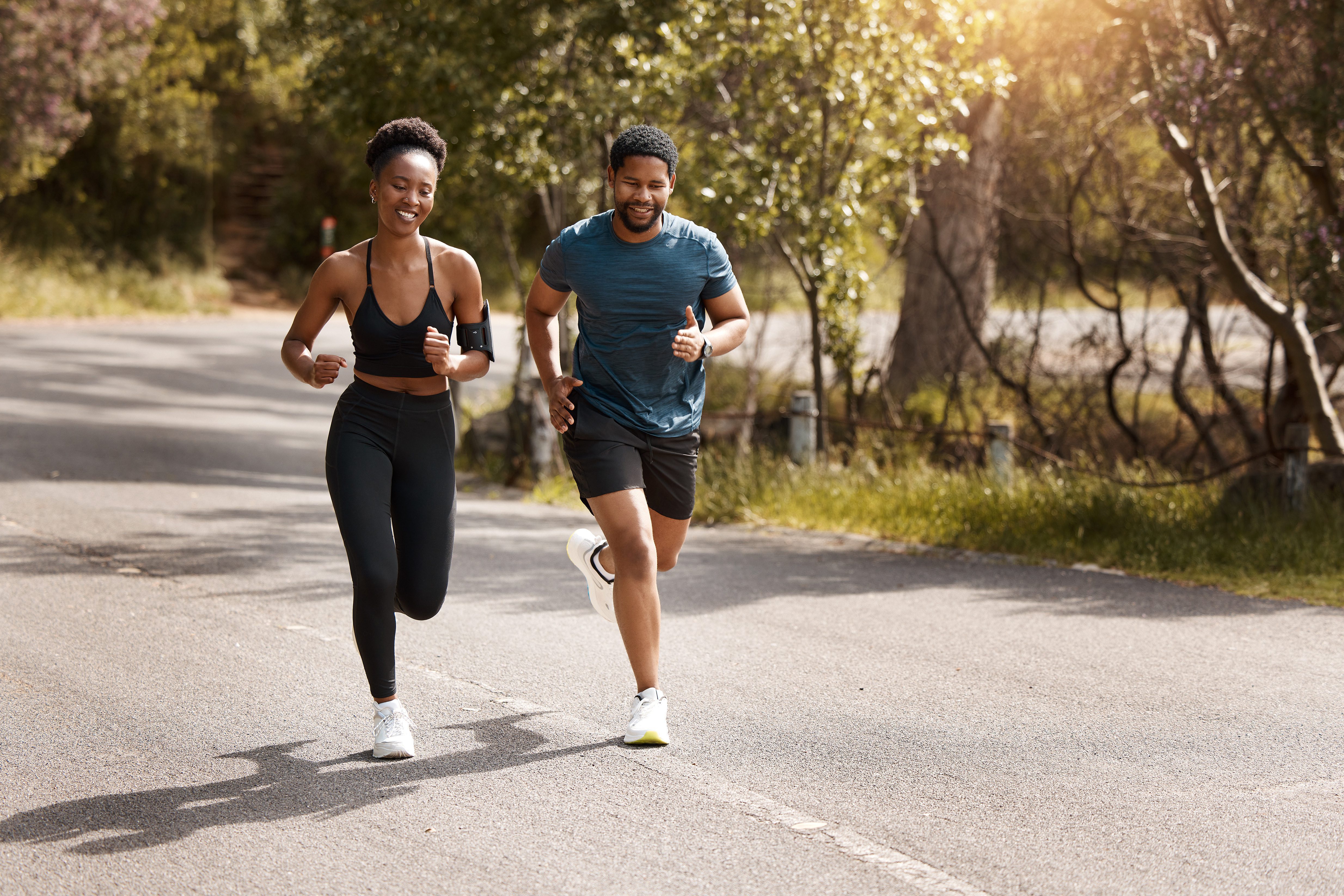
Highlights
- The average temperature in Canada is increasing at roughly twice the global average, meaning that training and competing in extreme heat is a reality that Canadian athletes of all levels must grapple with
- Exercise in heat increases cardiovascular, thermal and metabolic stress, and also results in a higher perception of effort, leading to reduced performance capacity
- This article provides an overview of the research related to heat exposure and exercise, and provides evidence-informed advice for training and competing in the heat
- This article has a sibling article on training and competing in extreme cold
While Canadians are used to severe winter weather, 9 of the 10 warmest years on record in Canada have occurred in the last 25 years. This has real world implications for outdoor sport events. For example, even the best triathletes in the world struggled with the extreme heat in Edmonton in July, with Paula Findlay and Kristian Blummenfelt forced to reduce their intensity in the later stages of the race, costing each of them the win (Professional Triathlon Organization July 24, 2022).
The trend of heat waves across Western Canada also led to the cancellation of the Manitoba Marathon mid-race. The known risks of exercise in extreme heat put too many amateur participants at risk. The move to cancel the event (even mid-race) was a smart choice by the organizers. While highly trained athletes possess a better capacity to regulate their body temperature in the heat (Douzi et al., 2019), amateur athletes can experience a significant increase in core body temperature during even relatively short (15km) running events in cool or temperate (11 degrees Celsius) conditions (Veltmeijer et al., 2015). Given that the average temperature in the country is increasing annually at roughly twice the global mean rate and many Canadian athletes travel to compete abroad, dealing with extreme temperatures when competing in the spring, summer and fall months is a reality that many will have to face.
Why exercising in the heat is such a challenge
When exercising in the heat, skin blood flow and sweat rate are increased to allow dissipation of heat to the environment (Racinais et al., 2015). Although beneficial to regulate body temperature, the increase in sweat contributes to dehydration, further exacerbating the physiological responses to exercise (Pryor et al., 2019). The higher physiological cost to maintain the same intensity of exercise alters the metabolic rate at which energy is produced, increasing the reliance on anaerobic energy. This leads to a higher rate of depletion of liver glycogen stores, increased metabolite accumulation and significantly higher lactate concentrations (Pryor et al., 2019). The increased cardiovascular, thermal, and metabolic stress, along with a higher perception of effort for any given work rate contribute to a significant reduction in performance (Périard et al., 2021). Fortunately, there are strategies that can help mitigate the effect that heat stress might have on performance.
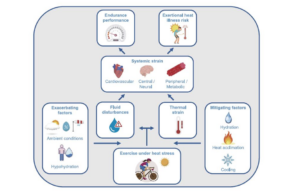
Dealing with heat
The science of how our bodies get better at dealing with heat is called heat acclimatization (HA) when occurring naturally (outdoors) or heat acclimation if it occurs in an artificial environment, like a laboratory. In either situation, the idea is to expose your body to the same environmental stress (in this case heat) to elevate internal temperature (core body) and skin temperatures, causing profuse sweating (Sawka et al., 1993). Just like in cold acclimation, the repeated environmental stress leads to adaptations that allow your body to better get rid of heat to control core and overall body temperature.
These changes occur in your cardiovascular system (heart and arteries), thermoregulatory (nerve receptors and your brain), metabolic (altering how you use energy), and perceptual (how you feel in the heat) during exercise in the heat, enhancing your ability to do more work with less heat stress (Chalmers et al., 2014). Heat acclimation also occurs quickly (within a week of repeated heat exposure), meaning you feel cooler, use less energy and have a lower heart rate if you persevere through that first week of heat exposure.
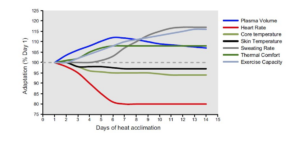
How to train to beat the heat
While the benefits from heat acclimatization seem to be more pronounced when it is done in the exact same conditions as the event will occur, acclimation (think of exercise in the heat indoors or in a lab, for example) has been shown to provide similar adaptations for endurance and team sport athletes if sufficient heat stress is provided.
For those that cannot perform a heat acclimation cycle, there are still plenty of options. Recent studies have demonstrated that passive heat exposure (for example, a post-exercise sauna or hot water immersion) can also lead to significant adaptations to heat (McIntyre et al., 2021). In fact, when the heat stress applied was the same, recreational athletes showed similar adaptations to exercise in the heat when compared to post-exercise hot water immersion (McIntyre et al., 2021). The use of saunas to elicit a heat stress response has also been shown to lead to similar adaptations as traditional heat acclimation, reducing heat stress during exercise and improving performance (Casadio et al., 2017; Kirby et al., 2021).
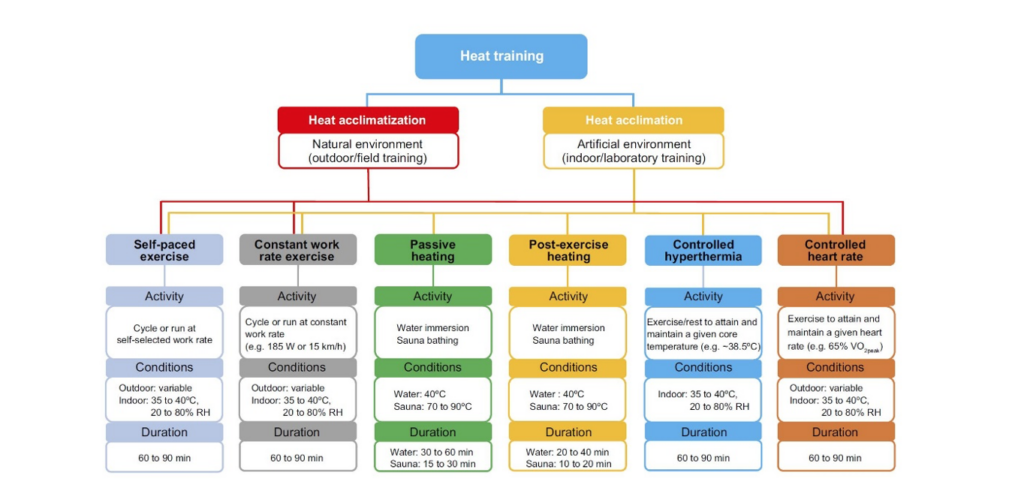
Planning a heat training program
Of the approaches listed above (figure 3) self-paced and controlled heart rate exercise are the most practical options. Self-paced exercise offers a sport-specific method of inducing adaptation, having been successful in improving performance in high level cyclists after a training camp (Périard et al., 2021; Racinais et al., 2015). For example, on your first day in the heat you could ride your bike (or run) for 60 minutes at a comfortable pace, with the effort controlled based on heart rate and perception of effort, for example. The second day could include a progression in the duration of the session, aiming to maintain the same overall perception of effort.
However, as your body adapts to the heat stress, it is necessary to provide a continuous overload to the system to ensure that the desired adaptations will occur. In this scenario, exercising with a target heart rate in mind (controlled heart rate approach) is a great option. In cyclists completing a 10-day heat acclimatization protocol, the power output to maintain the intended heart rate increased by approximately 25 watts (or about 15%) during the intervention (Travers et al., 2020). With this approach, you could start your heat acclimation with 60 minutes of cycling at 65% of your heart rate max. Maintaining the same target heart rate over the next few days, while increasing the duration of your sessions, should provide you with the required stress to continuously adapt to the heat.
The downside to these approaches is that exercising in the heat will force you to reduce your training load, affecting your training quality. If this is a concern, passive heat exposure is your best choice. Exercising in cool temperatures (such as riding indoors at the gym or virtual world cycling (like Peloton or Zwift in your basement) prior to a sauna or hot water immersion is a great option to maintain training quality and induce similar adaptations to the more traditional methods of exercising in the heat (Périard et al., 2021). For example, 40 minutes of hot water immersion (40 degrees Celsius, with water up to the neck) reduced the perception of effort and heat strain, improving running performance (in 33 degrees Celsius) in as little as 6 days (Zurawlew et al., 2016). So, if following the snowbirds south is not an option prior to your competition in early March, don’t worry! Perform your sessions as scheduled and make sure you can spend some time in the heat after you are done!
The following points, based on current research can inform your decision making when preparing to compete in the heat (Périard et al., 2021; Pryor et al., 2019; Sawka et al., 2015):
- Optimal heat acclimatization requires a minimum daily exposure of about 60 to 90 minutes (this can be extended to 2 hours and broken into hour long bouts) combined with exercise that is more aerobic in nature (think continuous exercise or practice scenarios where you keep the tempo high and have little rest)
- Exercise intensity can be progressively increased after the third day of heat exposure when most of the cardiovascular adaptations have already occurred.
- As the risk of exertional heat illness is reduced after the fourth day and tolerance to heat is increased, at this point it would be smart to perform training sessions that mimic the intensity of the event.
- For those utilizing hot water immersion or sauna to adapt to the heat, these strategies should be performed for periods of 15 to 60 minutes if no previous exercise has been performed. If these strategies are employed after a training session, heat exposure can be reduced to 10 to 40 minutes
- It is essential that athletes do not drink only when thirsty in these conditions, as it will likely lead to under drinking. Given the increased loss of electrolytes in sweat, consuming fluids containing electrolytes is also advisable
- Do not forget that the physiological stress of exercising in the heat should be included into the athlete’s training load calculations
- For female athletes, it is possible that a greater number of exposures to the heat is necessary for acclimatization to occur
As you can see, there are multiple ways to ensure you are ready to compete in the heat. The best news for you is that all of these methods have been shown to be effective in improving your performance in the heat. The obvious question you are asking yourself now is: which one do I choose? Pick and choose the one that fits your race (and life) schedule the best. Remember that your heat training should start 1 – 3 weeks before competition to ensure that you recover from your heavy training and also to allow you to perform a taper (Pryor et al., 2019).
Beating the heat during competition
So, what can you do if heat training is not an option? Regardless of the completion of a heat training protocol, cooling strategies can have a significant effect on performance on race or game day. Cooling strategies can be classified as internal, such as the ingestion of an ice slurry or cold beverage, or external, such as through the use of a cooling garment or cold-water immersion. These strategies can be employed before (pre-cooling) or during the event (per-cooling). Pre-cooling is focused on reducing core body temperature prior to the start of the event, while per-cooling focuses on reducing skin temperature and improving thermal perception during the event (Gibson et al., 2020). Since the pre-cooling effects of different strategies might be reduced after approximately 20 to 30 minutes, a combination of both types of cooling might be the most beneficial (Périard et al., 2021; Racinais et al., 2015).
Research suggests that cold water immersion seems to be the most effective pre-cooling method, leading to the largest benefits in performance, while utilizing an ice vest led to the largest benefits during the event.
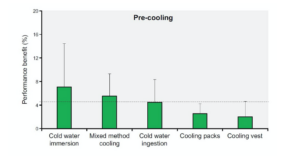
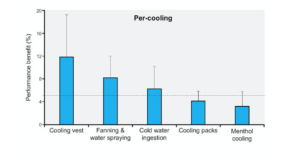
Bringing the recommendations to practice, here are some examples of what you can do to try to minimize the effects that heat might have on your performance (Douzi et al., 2019; Gibson et al., 2020; Périard et al., 2021; Racinais et al., 2015):
Prior to your event:
- If cold water immersion is not possible, there are other ways to cool down. Wearing a cooling vest or ingesting cold water or ice slurry can help.
- Using a fan or a water spray and a fan might be an easy to implement strategy.
- Cooling packs and ice towels may also be placed around the neck and torso to assist with heat stress.
- Remember that these strategies should be tested beforehand: for example, ingestion of ice slurry may lead to gastrointestinal distress during your race, so you should test out this strategy beforehand
During the event:
- When competing, wearing a cooling vest (if allowed during your event) is the best strategy.
- If the cooling vest is not a possibility, ingesting cold fluids or ice slurries is an effective way to reduce core body temperature and improve performance
- For team sports, ingestion of cold fluids or ice slurry is recommended in the break between quarters and at half-time (Gibson et al., 2020)
- Another possibility for team sports is to wear cooling vests at half-time, and to use cold towels, ice packs, and fans with misting spray during the breaks
Lastly, don’t forget that hydration is essential. Sweat rates of 1.0 to 1.5 liter per hour are common when performing intense activities in the heat (Racinais et al., 2015). Since sodium is the most common salt lost during exercise, it might be necessary (particularly for heavy and “salty” sweaters) to consume sports drinks containing sodium when exercising for longer than 1 hour (Pryor et al., 2019; Racinais et al., 2015). Consuming 30 – 60g / hour of carbohydrates or up to 90g / hour is also recommended for exercises longer than an hour or longer than 2.5 hours, respectively.
A final word on athlete health in the heat
Be aware that heat stress is a serious condition. While it is difficult to establish specific cut-offs across different sports for competing in the heat, it is important to be aware when risk is elevated.
Since the 1950s the most common method to report how the human body is dealing with the environment is called Wet Bulb Globe Temperature (WBGT). The term was developed to account for the various factors which ultimately affect a person in the environment; where the American National Weather Service defines it as “a measure of the heat stress in direct sunlight, which considers: temperature, humidity, wind speed, sun angle and cloud cover (solar radiation). Given that WBGT account for the push and pull of all these factors a comprehensive determination of heat stress on the body is provided and has been used effectively to guide decision making of exertion in the heat (Budd, 2008).
For this reason many environmental physiologists use WBGT and many guidelines for heat stress use WBGT as the combined value to report risk of heat stress (Brocherie & Millet, 2015). As you can see in Figure 5, as WBGT increases and you add increased relative humidity, heat stress increases. This highlights the importance that evaporative cooling has on controlling your heat stress, where high relative humidity reduces evaporation mechanisms leading to reduced ability to cool oneself.
For the purposes of your own decision making, it is instructive to check the relative humidity and if it is high, then note your ability to cool will be less (especially in non or low wind conditions). For those training through the Canadian winter, the risk seems to be higher right after the winter months, when athletes are not seasonally heat acclimatized (Gosling et al., 2008).
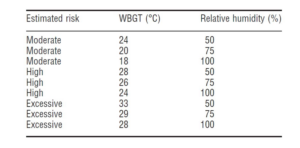
With temperatures remaining elevated in the coming years, competing in the heat is a reality. Fortunately, current sport science and environmental physiology research has provided some effective evidence-based strategies to assist with heat training prior to an event. Furthermore, on competition day or on a hard workout day we also know how cooling just prior to and during it can improve performance and reduce health complications.